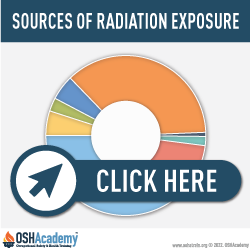Radiation Hazards
Radiation may be defined as energy traveling through space. Construction worker experience exposure to radiation regularly in the form of non-ionizing or ionizing radiation.
Ionizing Radiation
Ionizing radiation has enough energy to remove tightly bound electrons from atoms, creating ions. This process can damage DNA and cells, potentially leading to cancer. Examples include:
Ionizing radiation sources may be found during demolition and construction activities such as tunneling, highway and road construction. These radiation sources can pose a considerable health risk to affected workers if not properly controlled.
Alpha Particles: Alpha particles are emitted as radon decays. Radon is a common radioactive isotope and the primary source of exposure for construction workers. Alpha particles cannot penetrate skin, but when radon gas is inhaled, the alpha radiation from radon decay products can damage lung tissue at a cellular level, significantly increasing the risk of lung cancer.
Beta Particles: Beta particles are fast moving electrons emitted from the nucleus during radioactive decay. They travel considerable distances in air but can be reduced or stopped by a layer of clothing, but some beta particles are capable of penetrating the skin and causing radiation damage, such as skin burns.
Gamma Rays and X-Rays: Gamma rays are photons that can pass through several feet of concrete or a few inches of lead. Gamma rays can pass through the entire body. X-rays are high-energy photons produced by the interaction of charged particles with matter, and a few millimeters of lead can stop x-rays. Because of their many uses, x-rays are the single largest source of man-made radiation exposure.
Non-ionizing Radiation
This form of radiation has lower energy and does not ionize atoms. It can cause heat or vibration but is generally less harmful in typical exposure levels. Non-ionizing radiation includes each of the following:
- Extremely Low Frequency Radiation (ELF): Extremely Low Frequency (ELF) radiation at 60 HZ is produced by power lines, electrical wiring, and electrical equipment.
- Radiofrequency (RF) and Microwave Radiation (MW): RF radiation is emitted by various devices and equipment that use radio waves for communication, such as cell phones, Wi-Fi routers, and radio towers. Other sources include induction heaters, microwave ovens, and certain types of industrial equipment. Microwave radiation is absorbed near the skin, while RF radiation may be absorbed throughout the body. At high enough intensities, both will damage tissue through heating.
- Infrared Radiation (IR): The skin and eyes absorb infrared radiation (IR) as heat. Workers normally notice excessive exposure through heat sensation and pain. Sources of IR radiation include furnaces, heat lamps, and IR lasers.
- Laser Hazards: Lasers typically emit optical (UV, visible light, IR) radiations and are primarily an eye and skin hazard. Common lasers include CO2 IR laser, helium-neon, neodymium YAG, and ruby visible lasers, and the Nitrogen UV laser.
- Visible Light Radiation: The different visible frequencies of the electromagnetic (EM) spectrum are "seen" by our eyes as different colors. Good lighting is conducive to increased production and may help prevent incidents related to poor lighting conditions. Excessive visible radiation can damage the eyes and skin.
- Ultraviolet Radiation (UV): Ultraviolet radiation (UV) has a high photon energy range and is particularly hazardous because there are usually no immediate symptoms of excessive exposure. Sources of UV radiation include the sun, black lights, welding arcs, and UV lasers.
Knowledge Check Choose the best answer for the question.
9-12. What form of ionized radiation is produced by the decay of radon?
You forgot to answer the question!

